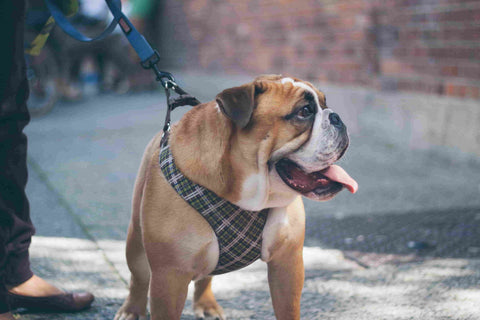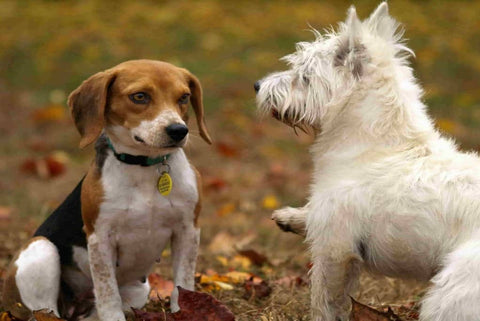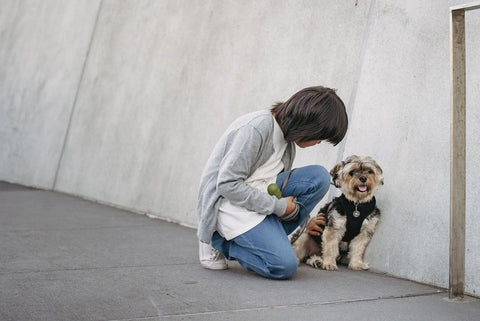Guide to Escape-proof Dog Harnesses
Does your dog squirm and twist out of his harness just as soon as he's put into it? You may think that your dog is a regular Houdini, but it's more likely that he's just not wearing the right harness. And the good news is that you don't need a complicated harness with tons of straps and clips to get Fluffy to stay inside it. Instead, simply getting a properly fitting harness will help keep him from escaping. Of course, there are other features you should look for when shopping for the best dog harness for your escape artist, like breathable fabric and intuitive use, but the key is sizing. Here's what you need to know about the best harness for dogs that escape.
How to Get the Right Sized Harness
To make any harness an escape-proof harness, you need to make sure that you choose the right size and get the perfect fit. It can be hard to know what size your dog is just by looking, especially if she's a mix with unusual proportions. To help make buying the right size harness easier, we have tools and reference charts you can use to measure your dog and get the right size and fit. Here are five simple steps to getting that perfect escape-free dog harness.
Step 1: Measure Your Dog's Neck
With a flexible measuring tape, measure around the base of your dog's neck. Be sure not to pull too tightly; otherwise, you could end up choosing the wrong size.
Pro-tip: If you don't have a flexible measuring tape, use a piece of string or yarn. Use a pen to mark the point where the string meets around your dog's neck. Then, lay it down flat against a standard measuring tape or ruler to find the measurement.
Step 2: Measure the Dog's Belly
At this point, you'll want to measure around the widest part of your dog's body with the same measuring tool you used for the neck. Again, be sure not to hold it too snugly, or you might get inaccurate measurements.
Step 3: Measure the Dog's Body Length
To measure your dog's body length, hold your measuring tape along the dog's back, from just behind the front legs to just behind the back legs.
Step 4: Find the Appropriate Dog Harness Size
Once you have your measurements written down, check out our size reference chart and compare your numbers. You should be able to find the perfect dog harness size there.
Step 5: Adjust the Escape-proof Harness on Your Dog
Dogs' proportions and sizes vary widely, so there's no one-size-fits-all dog harness. After you've purchased the right size harness, it's time to adjust it to your dog's body to turn it into the ultimate escape-proof dog harness. Check out how all the adjustable straps work and what parts of the harness they affect. It shouldn't be too tight that it hurts your dog, nor should it be so loose as to allow it to slip out of the harness entirely.
How to Achieve a Proper Fit
To turn your harness into a no-escape dog harness, you need the proper fit. Here are two tips that will help you keep Fido safe.
Tip 1: If your dog's measurements don't clearly match up to size on our reference chart, choose the larger size. When making your selection, judge the size based on the data (the measurements you took) and not previous experience to prevent injury to your dog.
Tip 2: To make sure that the size is correct and the harness is adjusted properly, make sure you can slip two fingers underneath any given strap. Any tighter and your dog could face breathing issues or skin chafing. To see if the harness is too loose, try to pull it up over your dog's head. If you can, you need to tighten it before your four-legged escapee goes on the run!
Features to Look for in an Escape-Proof Harness
As we mentioned above, making sure your harness is escape-proof is as easy as buying the right size and adjusting to get the proper fit. However, there are some features to look for in the best escape-proof dog harness that will enhance your dog's safety.
- The material used in the harness should be high quality and durable to resist your dog's escape attempts. The fabric should also be soft and breathable; if your dog's harness is comfortable, he may be less likely to escape.
- The harness should be lightweight and well-designed so that your dog feels safe and secure – not restricted. He should have a full range of motion and not feel tied up.
- The design should be convenient for the owner to use. Putting it on your dog should be easy for both of you. An intuitive design means you're more likely to use it instead of your dog's regular collar – which is not escape-proof itself.
- The harness should have several clip locations so you can find one that your dog responds best to. Finding that perfect spot will further encourage your dog to stay put in the harness.
- There should be several ways to adjust the fit of the harness. This will accommodate your dog's unique proportions and any changes in weight or hair growth.
Are Pet&Cuddle's Dog Harnesses Escape-proof?
Pet&Cuddle superior dog harnesses are indeed escape-proof when they have been purchased according to our sizing chart and adjusted properly. Each collection of our harnesses is designed by dog experts and created to ensure maximum safety and comfort for dogs and their parents.
The materials we use are soft and breathable to prevent any discomfort to your dog while wearing. Several adjustable straps make fitting the harness to your dog easy, so even the best escape artists won't slip out of it during playtime or training.
Overall, Pet&Cuddle harnesses are a standout option for dogs that tend to escape. Each model is designed with the four basic principles of the best dog harnesses in mind:
- Safety. Keeping your dog healthy and secure is the goal of any harness. We only use soft, breathable materials that won't irritate your dog's skin or cause undue pressure. Multi-point adjustments mean you can get just the right fit for your dog and prevent any escape issues. If your dog escapes the harness, he could face some serious harm, especially in an unfamiliar area.
- Control. Walking an escape artist dog can be pretty tricky, so you need to be in control of their movements. The reflective straps of our harnesses make sure that your dog is easy to see and control.
- Training. A good harness is an essential tool during training. Our models have been designed to make sure your dog is safe and comfortable while doing any kind of sports activity or agility training.
- Functionality. Multiple clip locations around the dog harness allow you to choose where you will clip your dog's leash. Leash clip location can affect your dog's response, safety, and comfort during different activities, like hiking, running, walking, or training. Having options means maximizing your dog's potential.
To find the ideal dog harness for your furry friend, check out our collection.
Questions About Escape-Proof Dog Harnesses
Find answers to the most common questions about dog harnesses below.
Can I train my dog with the escape-proof dog harness?
An escape-proof harness is a perfect choice for training. It will ensure his safety and comfort during high-activity training and will teach any escape artist dog to wear a harness.
Is the front clip or back clip harness harder to back out of?
The most important part of a no-escape dog harness is that it is the correct size and is adjusted properly. If that is done, your dog should not be able to back out of a front or back clip harness.
At what age should a dog start wearing harnesses?
Veterinarians generally recommend that you start harness- and leash-training your puppy when it reaches 8-10 months old. This is considered full-grown for many smaller breeds, and most breeds will be able to handle the weight of a harness. Before then, the puppy's body isn't strong enough.
How can I train my dog to wear a dog harness?
When you begin training your dog to wear a harness, start slowly and give your dog plenty of time to adjust to the new item. Let him smell it first, then try putting it on him for a couple of minutes at a time. As he gets used to it, add more time and begin activities. Sometimes it helps to distract your dog from the harness with treats or games.
What should I do if my dog keeps escaping their harness?
If your dog still keeps escaping his harness, it's probable that you need to remeasure and double-check the sizing. Follow the above guidelines for measuring and make sure that your chosen harness has several points of adjustment for the perfect fit.
Get the Best Escape-Proof Harness for Your Dog!
If you're ready to get the best escape-proof harness for your dog, you should look for a comfortable, functional, and secure option that fits your dog. Extra features like reflective straps and versatile leash-clip options are also a good idea to seek out.
At Pet&Cuddle, we create premium dog products for all different breeds – including the most skilled escape artists on four legs. Now that you know all the essential information for getting the best no-escape dog accessories at our shop, from harnesses to leashes, we're certain you'll find what you're looking for in our shop.
Pet&Cuddle knows dogs, and our experts are constantly working on making the best products and accessories for all of them. With a wealth of knowledge and practical experience, we've created the perfect harnesses with a unique design for your dog. Find the ultimate in comfort and safety for walking, running, training, and more at Pet&Cuddle.
Check out our latest products for dogs here!




